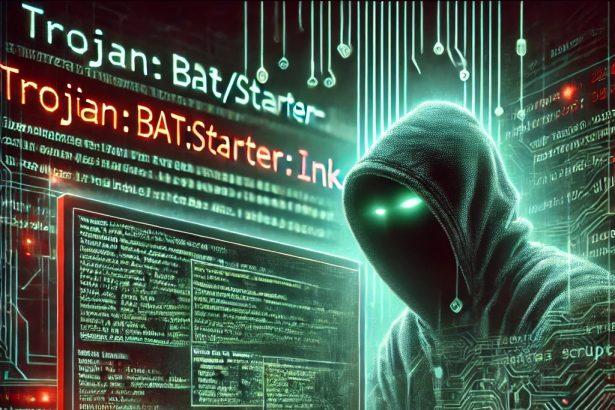Behavior:Win32/Rugmigen.B is a Trojan horse malware disguised as an Adobe Reader setup file. This malware primarily targets already compromised systems, acting as a loader to install additional malicious software. It is known for its ability to evade detection, steal sensitive data, and create vulnerabilities that hackers can exploit.
Users often encounter this threat when downloading software from untrusted sources, opening phishing emails, or visiting malicious websites. Since it operates stealthily, it can remain undetected for long periods, leading to significant damage.
Behavior:Win32/Rugmigen.B Malware – Threat Summary
| Attribute | Details |
|---|---|
| Threat Name | Behavior:Win32/Rugmigen.B |
| Threat Type | Trojan Horse / Malware |
| Danger Level | High |
| Symptoms of Infection | Slow computer performance, system crashes, excessive CPU usage, frequent pop-ups, unauthorized data access |
| Detection Names | Trojan:Win32/Rugmigen.B, TrojanDropper.Win32.Rugmigen.B, Backdoor.Win32.Rugmigen |
| Distribution Methods | Bundled downloads, phishing emails, fake Adobe Reader installers, malicious ads |
| Associated Email Addresses | Often uses phishing emails with fake invoice or software update attachments |
| Primary Damage | Installs additional malware, steals sensitive data, enables remote control by hackers, exploits system vulnerabilities |
| Persistence Mechanisms | Alters registry entries, encrypts malicious files, hides within system processes |
Behavior:Win32/Rugmigen.B Loader – How Did It Get on My System?
If your antivirus software detects Behavior:Win32/Rugmigen.B, it means your system is already infected. This Trojan commonly infiltrates computers through:
- Unverified software downloads – Particularly from torrent sites or unofficial freeware sources
- Phishing emails – Messages disguised as software updates or invoices containing malicious attachments
- Fake updates – Pop-ups or alerts prompting users to download an essential update
- Compromised websites – Clicking on malicious ads or drive-by downloads
- Bundled malware – Hidden within software packages, often installed without explicit user consent
Since this malware is designed to evade detection, users may not realize their system is infected until it begins to slow down, crash, or show other unusual behavior.
Key Features and Risks of Behavior:Win32/Rugmigen.B Malware
Spreads Other Malware
This Trojan acts as a loader, secretly downloading and installing spyware, ransomware, and other harmful programs.
Exploits System Weaknesses
It modifies critical system settings and registry files to remain undetected while maintaining access to the system.
Steals Sensitive Data
Hackers can use this malware to collect banking details, passwords, login credentials, and personal data, leading to identity theft or financial fraud.
Allows Remote Control by Hackers
It connects to a command-and-control server, enabling cybercriminals to execute commands, install additional threats, and manipulate the infected system.
Highly Persistent and Difficult to Remove
The malware hides itself using encryption and system modifications, making it resistant to standard removal techniques.
How to Remove Behavior:Win32/Rugmigen.B Malware
Step 1: Enter Safe Mode with Networking
- Restart your computer and press F8 (or Shift + F8) before Windows boots.
- Select Safe Mode with Networking from the list.
Step 2: Delete Suspicious Processes
- Press Ctrl + Shift + Esc to open Task Manager.
- Look for unfamiliar or high-resource-consuming processes.
- Right-click and select End Task.
Step 3: Uninstall Suspicious Programs
- Open Control Panel → Programs and Features.
- Find unknown or recently installed programs.
- Click Uninstall and follow the prompts.
Step 4: Remove Malware Entries from Registry
- Press Win + R, type regedit, and hit Enter.
- Navigate to HKEY_LOCAL_MACHINE\Software\Microsoft\Windows\CurrentVersion\Run.
- Look for suspicious entries and delete them.
Step 5: Run a Full System Scan
- Download and install SpyHunter or another trusted anti-malware tool.
- Run a deep scan and remove all detected threats.
Step 6: Clear Temporary Files
- Press Win + R, type %temp%, and hit Enter.
- Delete all temporary files.
How to Prevent Future Infections
- Avoid Downloading from Untrusted Sources – Stick to official software providers.
- Use a Reliable Antivirus Program – Keep it updated and scan regularly.
- Beware of Phishing Emails – Do not open attachments or click links from unknown senders.
- Keep Software and Windows Updated – Install security patches promptly.
- Enable a Firewall – Helps block suspicious network activity.
Conclusion
Behavior:Win32/Rugmigen.B is a dangerous Trojan that compromises system security, steals sensitive data, and installs additional malware. It often spreads through phishing emails, fake software downloads, and system vulnerabilities. If infected, users should act quickly by following the removal guide and enhancing their cybersecurity measures to prevent future infections.
By staying cautious, using reliable security software, and avoiding risky downloads, you can protect your system from such threats.\




